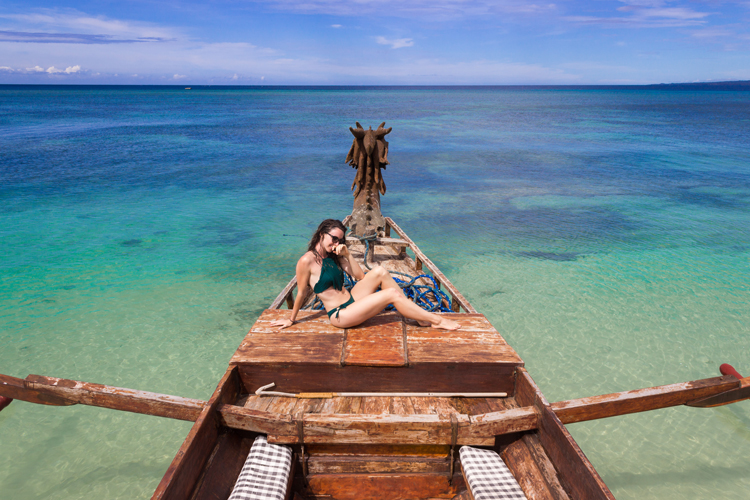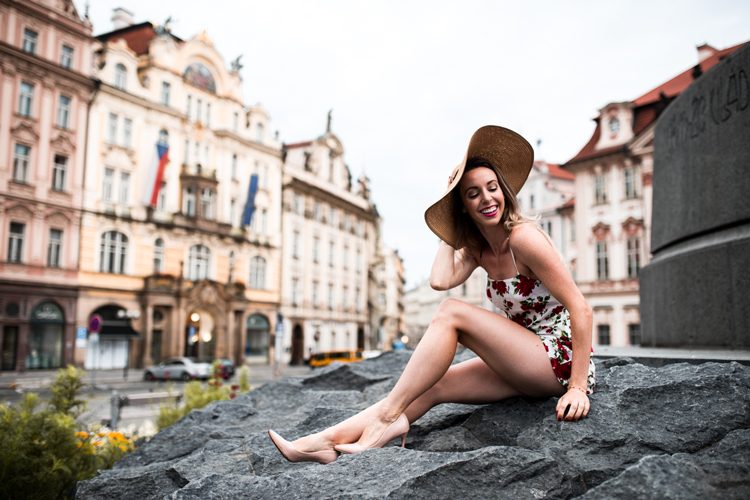Some travel bloggers have become so successful at what they do, they are now giving back and teaching others their trade.
Case in point: Sarah Funk, who has been traveling the world since January 2017. She runs SarahFunky.com, a travel and adventure brand, and teaches a course on how to travel the world and make money doing it. Sarah holds an MBA from Zicklin School of Business in Marketing and Entrepreneurship. Prior to running her own travel brand, she did North American marketing strategy for Disney.
In an exclusive interview, Sarah tells us how to pitch brands, why blue photos work best on Instagram, and more!
You teach a course on how to travel the world and make money doing it. One of the sections is called “reaching more people through press and publicity.” What recommendations do you have for aspiring travel bloggers looking to get known?

Gili Islands, Indonesia | SarahFunky
The most important part is to create a “newsworthy story”.
Anything that a travel blogger pitches to the press should have three key characteristics: interesting, timely, and relevant.
They should put themselves in the editor’s shoes and ask “Why should this story be published in this publication?” Keep in mind, that editors/press receive hundreds of submissions a day. Your submission should stand out from the rest. To do this, pitch relevant publications that already discuss similar topics. A travel blogger should start pitching local publications first, then expand to national. There is always a greater chance of success with a local publication, especially if the travel blogger is from that area because then there is already a “relevant” connection.
Another section is called “creating an irresistible pitch to brands.“ What does such a pitch involve?” What documents (email templates, media kits, collab proposals) should bloggers elaborate?

Lima, Peru | SarahFunky
Pitching brands is somewhat similar to pitching journalists, however, there needs to be more focus on how the relationship can benefit the brand and in the end, their sales.
The first step is to email the right person. Find the right person by carefully reading the brands contact page or searching on LinkedIn.
Next, write your pitch email. Be sure that the main focus of your pitch focuses on the value that you can offer to the brand and how working with you can help them to further their mission or goals.
Any pitch email should have four main sections. They include: who you are, your objective, the idea, and the outcome. In the first section, take two to three sentences to discuss who you are and include any relevant accomplishments, skill set, stats from your site (media kit), or other things that would be of value to the brand about you.
In the second section discuss your objective. This is what you hope to achieve from this email. Make sure to focus on a specific need your are filling or opportunity you are providing. This should be two to three sentences.
Next is the most important part, the third section. It is your creative concept or idea. Make this a brief, smart, to-the-point outline that is 1-2 paragraphs with ideas and strategies of how you’ll benefit the brand you’re pitching. Be creative, bold and flexible. A general explanation of how the idea will work and what you will need in order to complete your project and achieve the desired results. Include examples of past work that you’ve done that may be a great example.
In the fourth section, let the brand know what they will be getting out of this opportunity. Include a cost breakdown with all the items and services that you’re expecting the brand to contribute to your project. You should also mention that you are happy to hop on a phone call or discuss further if they have questions or would like to talk it out.
How did you yourself establish yourself as an authority in your field?

Buenos Aires, Argentina | Maria Jesus
I consistently created high-quality content about travel and adventure, then started to attend events that travel professionals went to and established relationships with them. After creating good relationships with travel industry professionals, such as tourism boards, brands, writers, publications, and bloggers, I began to create free content for them in exchange for free tours or experiences, distribution, or features on their site. Eventually I leveraged these strong relationships and asked for paid work. Today, I have a strong network of travel contacts that I work for and with all around the world.
How did you grow (and continue to grow!) your following on Instagram?
A few years ago, it was much easier to grow on Instagram than it is today because of shifts in how the platform features content. However, my advice to those that want to grow their Instagram today is to partner with others in the industry for features on their accounts, continuously share very high-quality content, and post a lot of blue photos!
This might sound crazy but photos that are blue (such as aqua blue water) tend to do really well. Also, sunset shots tend to do extremely well. Sounds silly but it really works!
And finally, what advice do you have for getting free hotels, tours or vacations?

Lima, Peru | Kike Sanchez
The most important part of asking for free hotels, tours, or vacations is to have a real, engaged audience that the hotel/tour will benefit from reaching. In general, you should be providing double the value of the free experience in exchange for it.
For example, if you have 10,000 real followers on Instagram, you should generally charge $100 for a sponsored brand post. Therefore, if you get a free tour that is worth $50, one Instagram post should be enough reach to be equal value to the cost of the tour.
When you pitch hotels and tours, first share your reach and following with them, then show them examples of past collaborations that would be similar to what you will do for them. For example, when I pitch a hotel, I be as specific as possible as to why that is the ideal hotel for my audience. I make sure that I mention one or two detailed sentences about why the hotel is special for me and why I want to write about it. Such as “It has been a dream of mine to stay at ABC Hotel for years. It would be incredible to spend the night in a storied mansion that is 5 centuries old and dine on local cuisine from ABC Restaurant.” The more specific and relevant you can make the pitch to the hotel/tour the better. Prove to them that by giving you this free experience they will benefit.
Find out more about Sarah’s course here, and visit her website, Instagram, Youtube, Twitter and Facebook channels here.

